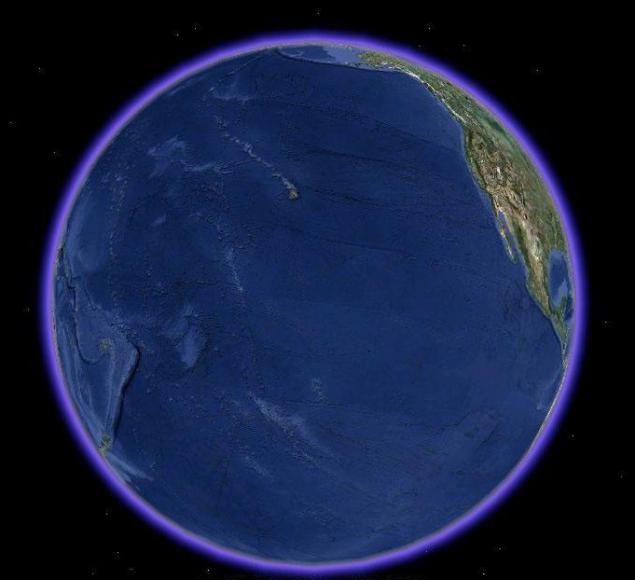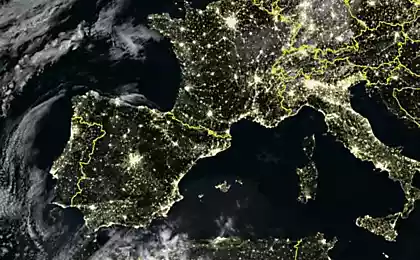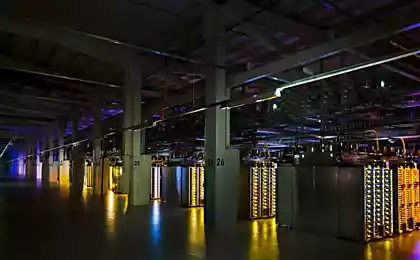1217
Google is planning to lay its own fiber optic cable along the bottom of the Pacific Ocean
Google plans to invest in a multi-million dollar project of laying fiber optic cable along the bottom of the Pacific Ocean, which will link their data center in Oregon with Japan.

From this perspective seen strip US coast, but Japan - no longer exists. To understand the scope of the project. I>
Google Inc. is laying its own fiber optic cable along the bottom of the Pacific Ocean, according to Wall Street Journal . Preliminary project cost is estimated at $ 300 million. The basis can be realized in 2008 «Cabel-Projekt Unity», while the US and Japan was laid cable length of more than 10 thousand. Km. It is planned that the company will be created independently control its section of the network and will be able to use it at their own discretion. Primarily, this will allow the tech giant to link their data centers in the US, Oregon, with a network infrastructure in Japan.
In these plans Google clearly observed giant desire to reduce dependence on data networks owned by a State or third party companies (some 40% of the traffic passes through the private network), and start building a full-scale global network, controlled by the corporation.
It is worth recalling that the draft broadband, high-speed access to the Internet on the basis of fiber-optic communication from Google, titled Google Fiber already creating tangible competition to provide access to the World Wide Web in the US market, where it is possible to connect. If we take into account the fact that the company systematically creates its own ecosystem, as is illustrated by the implementation of Fiber, it becomes clear that the laying of the cable, which will connect the western coast of Japan (read Asia) - only a small part of an ambitious plan of Google.
This step is logical. Having mastered the part of the United States market brainchild of Larry Page and Sergey Brin wants to force things, and not waiting for the saturation of an existing market to develop new open spaces. Exit to Japan will allow us to go further - to the huge Asian market, where there are still densely populated area with no connection to the outside world in the form of high-speed access to the World Wide Web.
Incidentally, such a project - it is not the first embedding Google data network. The company has already invested in such projects: in 2010, Google has participated in the international telecommunication projects «Southeast Asia-Japan Cable», which was aimed at strengthening the information security of the South Asian region. Just Goolge long been buying abandoned fiber optic and, to date, researchers estimate that already has more than 160 000 km of fiber optic networks worldwide.
If this rate of development of its own network infrastructure will continue, Google soon enough be able to enter the market to provide access to the Internet in many parts of the world.
It is also worth to remember about Facebook, more precisely, the purchase of British Aerospace Companies Ascenta, by which (satellites and drones) soc. Network plans to provide network coverage in remote regions where the quality or the fact of having access to the internet is poor.
On a possible plan to take over the world do not want to think. I> h6>

From this perspective seen strip US coast, but Japan - no longer exists. To understand the scope of the project. I>
Google Inc. is laying its own fiber optic cable along the bottom of the Pacific Ocean, according to Wall Street Journal . Preliminary project cost is estimated at $ 300 million. The basis can be realized in 2008 «Cabel-Projekt Unity», while the US and Japan was laid cable length of more than 10 thousand. Km. It is planned that the company will be created independently control its section of the network and will be able to use it at their own discretion. Primarily, this will allow the tech giant to link their data centers in the US, Oregon, with a network infrastructure in Japan.
In these plans Google clearly observed giant desire to reduce dependence on data networks owned by a State or third party companies (some 40% of the traffic passes through the private network), and start building a full-scale global network, controlled by the corporation.
It is worth recalling that the draft broadband, high-speed access to the Internet on the basis of fiber-optic communication from Google, titled Google Fiber already creating tangible competition to provide access to the World Wide Web in the US market, where it is possible to connect. If we take into account the fact that the company systematically creates its own ecosystem, as is illustrated by the implementation of Fiber, it becomes clear that the laying of the cable, which will connect the western coast of Japan (read Asia) - only a small part of an ambitious plan of Google.
This step is logical. Having mastered the part of the United States market brainchild of Larry Page and Sergey Brin wants to force things, and not waiting for the saturation of an existing market to develop new open spaces. Exit to Japan will allow us to go further - to the huge Asian market, where there are still densely populated area with no connection to the outside world in the form of high-speed access to the World Wide Web.
Incidentally, such a project - it is not the first embedding Google data network. The company has already invested in such projects: in 2010, Google has participated in the international telecommunication projects «Southeast Asia-Japan Cable», which was aimed at strengthening the information security of the South Asian region. Just Goolge long been buying abandoned fiber optic and, to date, researchers estimate that already has more than 160 000 km of fiber optic networks worldwide.
If this rate of development of its own network infrastructure will continue, Google soon enough be able to enter the market to provide access to the Internet in many parts of the world.
It is also worth to remember about Facebook, more precisely, the purchase of British Aerospace Companies Ascenta, by which (satellites and drones) soc. Network plans to provide network coverage in remote regions where the quality or the fact of having access to the internet is poor.























